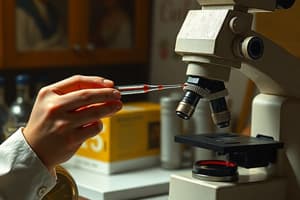Podcast
Questions and Answers
Which factor can lead to a falsely increased hematocrit result?
Which factor can lead to a falsely increased hematocrit result?
- Chronic disease
- Increased fluid intake
- Intense physical exercise
- Dehydration (correct)
What is the expected hemoglobin value calculated using the Rule of Three for an RBC count of $5.4 \times 10^{12}/L$?
What is the expected hemoglobin value calculated using the Rule of Three for an RBC count of $5.4 \times 10^{12}/L$?
- 17.0 g/dL
- 16.2 g/dL (correct)
- 16 g/dL
- 15.4 g/dL
Which situation would likely cause a falsely decreased hematocrit?
Which situation would likely cause a falsely decreased hematocrit?
- Excess anticoagulant content (correct)
- Hemoconcentration
- Inadequate centrifugation
- Physical dehydration
What discrepancy was identified in Case 2 regarding the Rule of Three?
What discrepancy was identified in Case 2 regarding the Rule of Three?
What is a possible reason for inaccuracies in hematocrit results in Case 2?
What is a possible reason for inaccuracies in hematocrit results in Case 2?
Flashcards
Hematocrit
Hematocrit
A measurement of the percentage of red blood cells in a blood sample.
Falsely Increased Hematocrit
Falsely Increased Hematocrit
A hematocrit reading that is higher than the actual value, due to factors like dehydration or insufficient centrifugation.
Dehydration
Dehydration
A condition where the body loses more fluids than it takes in, leading to a falsely higher hematocrit.
Hemoconcentration
Hemoconcentration
Signup and view all the flashcards
Insufficient Centrifugation
Insufficient Centrifugation
Signup and view all the flashcards
Buffy Coat Inclusion
Buffy Coat Inclusion
Signup and view all the flashcards
Falsely Decreased Hematocrit
Falsely Decreased Hematocrit
Signup and view all the flashcards
Hemolysis
Hemolysis
Signup and view all the flashcards
Rule of Three
Rule of Three
Signup and view all the flashcards
Normocytic and Normochromic
Normocytic and Normochromic
Signup and view all the flashcards
Study Notes
Potential Causes of Errors in Hematocrit
- Certain abnormal red blood cell (RBC) shapes (e.g., spherocytes, sickle cells) can prevent complete packing, leading to inaccurate hematocrit (Hct) readings.
- Immediately after blood loss, plasma volume is replenished more quickly than RBCs, resulting in a temporarily lower Hct.
Causes of Falsely Increased Hematocrit
- Dehydration
- Hemoconcentration
- Insufficient centrifugation
- Buffy coat inclusion
Causes of Falsely Decreased Hematocrit
- Hemolysis
- Improper sealing of cap in sample tube
- Introduction of excess fluid (interstitial fluid)
- Increased anticoagulant concentration
Rule of Three for Hematologic Tests
- Used to verify the validity of test results for normocytic, normochromic specimens.
- Formula: RBC x 3 = Hemoglobin (Hgb), and Hgb x 3 = Hct
Sample Cases
-
Case 1 (Accurate Specimen): Male patient with RBC count of 5.4 x 1012/L, Hemoglobin (Hgb) of 16.4 g/dL, and Hematocrit (Hct) of 49%. Expected values calculated using the rule of three: 5.4 x 3 = 16.2(Exp. Hgb), and 16.4 x 3 = 49.2 (Exp Hct)
-
Case 2 (Inaccurate Specimen): Male patient with RBC count of 4.0 x 1012/L, Hgb of 3.2 g/dL, and Hct of 37%. Calculated using the rule of three : 4.0 x 3 = 12 (Exp. Hgb), and 3.2 x 3 = 9.6 (Exp Hct). Errors may include machine malfunctions or non-normocytic/non-normochromic specimens.
Studying That Suits You
Use AI to generate personalized quizzes and flashcards to suit your learning preferences.




